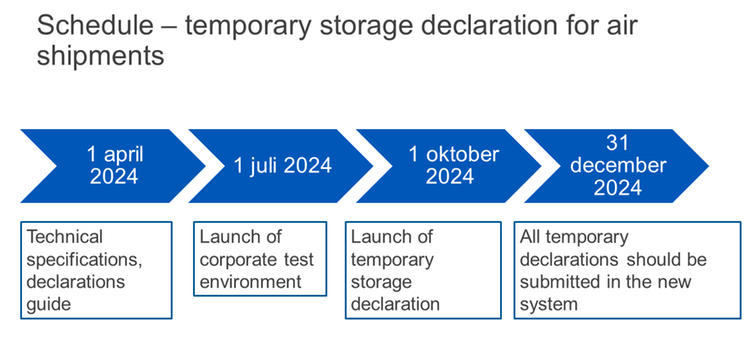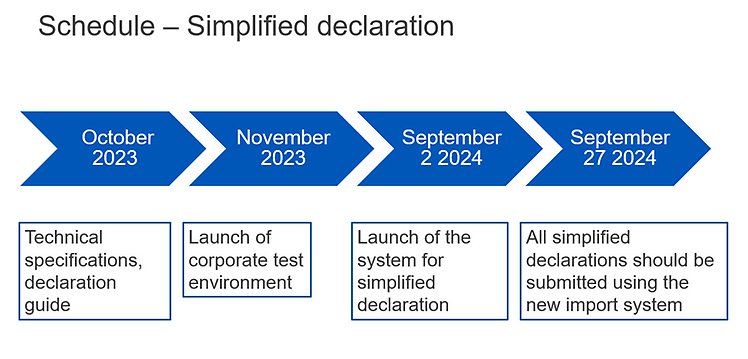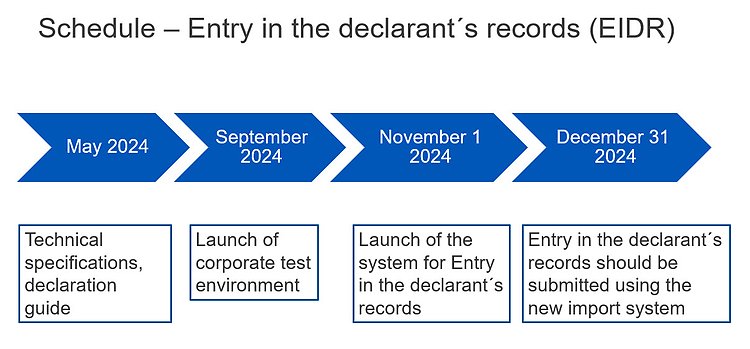
Future customs procedures
Schedule for the introduction of the Union Customs Code
The Union Customs Code is being introduced in stages over a transition period. You can follow the work on this page. Swedish Customs’ national schedule will be updated as work progresses, and we will be publishing dates of relevance for the introduction of, and migration to, new systems.
Release 3 of the import control system (ICS2) for transport by sea, road and rail.
Release 3 of the import control system (ICS2) will be introduced in 3 steps: Carriers (sea) 3 June – 4 December 2024, House filers (sea) 4 December – 1 April 2025, Road and rail 1 April – 1 September 2025.
Traffic from Norway and Switzerland will still be exempt from the requirement to file a presentation notification or summary declaration, as Norway and Switzerland are part of the Security Zone.
Presentation notification for goods transported by modes of transportation other than air
For road transport, it will be possible to digitally present goods at customs offices from 1 March 2024. It will also be possible to submit a digital I2 message. However, during a transition period the practical procedure will consist of the driver submitting a manual presentation in the form of the single administrative document (SAD) on paper, which fulfils the data requirements for presentation notification of goods.
At unmanned border crossings, it will also be possible to submit both a digital presentation notification as of 1 March 2024 or a digital I2 message. During a transition period, Swedish Customs will accept the e-mail notification made one hour before the border crossing as a condition for route and time exemptions (operating authorisation). Submitting a digital notification of arrival of goods and activating the customs declaration with a digital I2 message will be required. More information about the introduction of this requirement will be provided presently. Notification via e-mail will still be required as a condition for an operation authorisation.
Temporary handling will be replaced by digitalised border crossing when this is introduced on the basis of the joint EU project (EU Smart Border) that the European Commission intends to include in the Multi-Annual Strategic Plan (MASP).
For maritime movements, the requirement only applies to goods unloaded in Sweden. The presentation notification should refer to the entry summary declaration.
This will bring a change in procedures and new information requirements for actors submitting information. Regarding the current data filing system using the Maritime Single Window (MSW) in anticipation of the European Maritime Single Window (EMSW), it is clear that additional data will need to be submitted in the MSW from 3 June 2024. As there will be delays in the introduction of EMSW, which was scheduled to take place on 15 August 2025, the impact on presentation notifications is being analysed.
Temporary storage declaration
Swedish Customs will introduce a digital declaration for temporary storage for air shipments on 1 October 2024 with an implementation period until 31 December 2024. Until then, the transitional solutions that exist today will be used. For shipments by air, this means that the temporary storage declaration should be submitted by e-mail. We will return to how the delay of the European Maritime Single Window will impact the maritime flow
For the time being, the transitional solution that exists in the maritime flow regarding declaration for temporary storage is used, i.e., the data is submitted via the Maritime Single Window (MSW).
For shipments by air covered by IOSS, it is possible to consider a pre-lodged low-value declaration (H7) as a temporary storage declaration. Until 31 December 2023, the transitional rule that a notification of arrival of goods should be lodged using a temporary storage declaration applies. After that, a separate presentation notification for goods will be required.
Declarations of goods delivered by road will be seen as temporary storage declarations. Transit declarations in NCTS will be considered temporary storage declarations, which means that a separate temporary storage declaration will not be required for goods in transit.
 Zoom image
Zoom imageSchedule – temporary storage declaration for air shipments Click on the image to enlarge.
Proof of Union Status
Proof of Union Status will be introduced in two stages. The first stage involves the digitising of proof of Union Status (T2L/F), which will be launched on 1 March 2024. This means that from this date economic operators will apply for certification and register their T2L/F via an external centralised interface. The customs authorities will process the files and an authorisation will be given in each individual case. The MRN (Master Reference Number) provided in the reply should then be presented to the customs authorities upon arrival in the EU.
The second stage, which includes customs manifests, will be launched together with EMSW in Q3 2025.
Simplified import declaration
The simplified import declaration is scheduled for launch on 2 September 2024, with an implementation period that runs until 27 September 2024. One of the more significant changes is that 10-digit commodity codes will be required in the simplified declaration. Thus, current holders of a simplified declaration authorisation need to consider whether they still need to use a simplified declaration or whether they can use a standard customs declaration instead. If different operators submit the simplified and the supplementary declaration, both parties must switch to the new system at the same time.
 Zoom image
Zoom imageSchedule, simplified import declaration Click on the image to enlarge.
Entry in the declarant's records (EIDR), import
Entry in the declarant's records for import will be introduced on 1 November 2024, with an implementation period that runs until 31 December 2024. The level of details in these records must correspond with the requirements for a simplified declaration. There will also be a requirement to notify Swedish Customs whenever an entry is made in the declarant’s records.
 Zoom image
Zoom imageSchedule for entry in the declarant's records (EIDR). Click on the image to enlarge.
Centralised customs clearance, import
The two phases of centralised customs clearance will be introduced concurrently in Sweden. This is scheduled for 2 June 2025.
Central customs clearance will allow economic operators to submit customs declarations in a Member State, regardless of where the goods enter the EU.
This means, among other things, that when the procedure starts, data contained in the customs declarations will be exchanged digitally in real time between the Member States concerned. A centralised IT support to facilitate this exchange of information has been developed by the European Commission; however, this will require the integration and adaptation of the national IT support systems for import.
Centralised customs clearance will be implemented in two releases. The first release includes standard customs declarations and simplified declarations. The second release includes, for example, simplified and supplementary declarations and entry in the declarant's records.
In Sweden, the plan is to provide the option to start applying Release 1 on 2 June 2025.
We are currently analysing Release 2. We will therefore return later with a date for when Release 2 will be available.
 Zoom image
Zoom imageSchedule – Centralised customs clearance import. Click on the image to enlarge.
New export system
The development work is ongoing and the introduction of a new export procedure management system will go live on 1 October 2024 with an implementation period until 2 December 2024.
The aim is to adapt the export system to the new EU legislation, and the change involves digital management of export and exit procedures.
The development of a new export procedure system includes support for standard customs declaration, simplified declaration, supplementary declaration, exit notification and centralised customs clearance. The scope of the change is described in the European Commission's specifications for AES (Automated Export System) and the change entails, in addition to new IT support, changed processes and new data filing for actors who provide data. Even actors who currently do not provide data to Swedish Customs may be affected, for example at certain exit points. With regard to entry in the declarant's accounts, re-export notification and exit summary declarations that are lodged separately, this will be introduced somewhat later, i.e. in 2025. By 30 June 2025, all actors should fully apply the new regulatory framework for entry in the declarant's records.
 Zoom image
Zoom imageSchedule, export customs declaration. Click on the image to enlarge.
Analytical work
European Maritime Single Window
The European Maritime Single Window will ensure that all ships reports are made to a single point of contact per Member State. The Swedish Maritime Authority is responsible for this point of contact. It will be possible to submit required for customs purposes, i.e., notification of arrival of goods and temporary storage, using this single point of contact. The Swedish Environmental Protection Agency is the competent authority in Sweden.
The implementation is scheduled for 15 August 2025. The EMSW will then replace the Maritime Single Window, the current system. The implementation was originally scheduled for 15 August 2025, but will be delayed.
We are currently analysing the impact that this will have on customs formalities.
Information about EMSW from the Swedish Maritime Administration
Certex
Certex is a system for exchanging information about certificates and authorisations needed for import and export, which are issued by authorities other than customs authorities. Any certificates or authorisations that are currently issued on paper, will subsequently be available digitally in Certex.
The first release was implemented on 1 March 2023. It comprised Common Health Entry Documents (CHED) for imported animals and animal products, feed and non-animal foodstuffs, and plants and plant products.
A second release will be introduced on 15 March 2025, comprising an additional number of certificates and authorisations. Further certificates and licences will be added successively. With time, this will facilitate the management of authorisations and certificates for businesses and customs authorities.
Learn more about Certex on the website of the European Commission.
NCTS, Release 6
Release 6 is a further development of Release 5, whereby the customs authorities will be able to decide to receive safety and security information in the transit system (NCTS).
In Sweden, Swedish Customs has decided that security and safety information should be provided in the import control system, ICS2, i.e., not in the transit system, which the European Commission describes as 'opting out'.
The rollout of Release 6 in the EU and the convention countries is scheduled for the period
1 March 2025-1 September 2025.
Sweden plans to move to Release 6 on Sunday 1 June 2025.
Electronic transport document
The electronic transport document allows goods to be transited via the digital systems used by the economic actors. It may be used for transport by sea and air, and is scheduled to be introduced in 2025.
Customs warehouse upgrade
Our system for customs warehouses, implemented in 2016, needs to be upgraded to comply with the Union Customs Code. According to the current plan, this will be done in 2025 with an implementation period until 31 December 2025.
Binding Value Information and Binding Origin Information
There are plans to launch additional central IT support resources, similar to those for Binding Classification Information (BCI), for Binding Origin Information (BOI) and Binding Value Information (BVI).
They will consist of a central system with a central external interface for traders to manage applications, but also central functions to manage and store these cases. This is expected to be implemented in 2026.
Digital proof of origin
A database for digital proof of origin (e-PoC) is also planned, where proofs of origin can be stored centrally, where they are accessible to customs authorities. This is expected to be implemented in 2028.
The European Commission has decided to grant a derogation under Article 6(4) of the Customs Code to allow the use of data exchange and storage methods other than electronic data processing techniques for a certain limited transitional period, which in practice results in an extension of the deadline for implementation of presentation notifications for means of transport, the presentation notifications for goods, temporary storage and the national customs declaration systems for imports. The decisions are directed at Member States that have applied for a derogation, which include Sweden.
Swedish Customs’ implementation plan
Swedish Customs’ implementation plan indicates at what point in time different systems are developed. At the end of the arrows, economic operators should have submitted all required information, in accordance with the new legislation and in the new or upgraded systems.
 Zoom image
Zoom imageSwedish Customs’ implementation plan. Click on the image to enlarge.
Information about other Member States’ work programmes can be found on the website of the European Commission.
Last updated:
What is updated: Updated information regarding New export system and Swedish Customs’ implementation plan.
